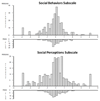Refinement and Validation of the Social Participation Restrictions Questionnaire: An Application of Rasch Analysis and Traditional Psychometric Analysis Techniques
- PMID: 29905669
- PMCID: PMC7617168
- DOI: 10.1097/AUD.0000000000000618
Refinement and Validation of the Social Participation Restrictions Questionnaire: An Application of Rasch Analysis and Traditional Psychometric Analysis Techniques
Abstract
Objectives: The primary aim of this research was to refine and validate the Social Participation Restrictions Questionnaire (SPaRQ). The SPaRQ is a hearing-specific, patient-reported outcome measure that was originally developed through consultation with adults with hearing loss, clinicians, and researchers. This research comprised two studies. Study 1 aimed to assess the psychometric properties of the SPaRQ and to improve these properties by amending the questionnaire (e.g., removing items) as required. Study 2 aimed to validate the refined SPaRQ.
Design: In study 1, 279 adults with hearing loss completed a long-form, 53-item SPaRQ. Rasch analysis, a modern psychometric analysis technique, was used to assess a range of psychometric properties for the questionnaire (e.g., unidimensionality, fit to the Rasch model). The properties of the individual items were also assessed (e.g., response dependency, differential item functioning). In study 2, 102 adults with hearing loss completed the refined SPaRQ. In addition, they completed three questionnaires that had been designed to measure related constructs. These were a hearing-specific questionnaire (Hearing Handicap Inventory for the Elderly), a generic health and disability questionnaire (shortened World Health Organization Disability Assessment Schedule 2.0), and a brief depression and anxiety screening questionnaire (Patient Health Questionnaire-4). Traditional psychometric analysis techniques (e.g., Cronbach's alpha) were used to assess the construct validity and internal consistency of the refined SPaRQ.
Results: Rasch analysis was used to refine the SPaRQ. The result was a 19-item measure divided into two subscales. The 9-item Social Behaviors subscale measured difficulties with performing actions in a social context due to hearing loss. The 10-item Social Perceptions subscale measured negative thoughts and feelings experienced in a social context due to hearing loss. Both Rasch analysis and the traditional psychometric analysis techniques demonstrated that each subscale had strong psychometric properties. In particular, each subscale passed the test of unidimensionality, displayed good fit to the Rasch model, and had high internal consistency. In addition, it was found that, as predicted, each subscale had strong, positive correlations with the hearing-specific questionnaire and moderate, positive correlations with the generic health and disability questionnaire and the depression and anxiety screening questionnaire. Taken together, these findings support the construct validity of the 19-item SPaRQ.
Conclusions: This was one of the first studies to devise a new hearing-specific outcome measure using Rasch analysis. Rasch analysis proved to be a powerful technique for supporting decisions regarding which items to retain in order to achieve a psychometrically robust questionnaire. Additional support for the robustness of this questionnaire came from the utilization of traditional psychometric analysis techniques. Therefore, this questionnaire has the potential to be used in research and clinical practice to evaluate whether auditory rehabilitation interventions improve social participation in adults with hearing loss. The next stage of this research will be to further validate this questionnaire by assessing its responsiveness in a clinical population. The combined use of modern and traditional psychometric analysis techniques should be considered in future questionnaire development and validation research.
Figures
Similar articles
-
Refinement and Validation of a New Patient-Reported Experience Measure for Hearing Loss (My Hearing PREM).Health Expect. 2025 Apr;28(2):e70225. doi: 10.1111/hex.70225. Health Expect. 2025. PMID: 40088002 Free PMC article.
-
Refinement and Validation of the Empowerment Audiology Questionnaire: Rasch Analysis and Traditional Psychometric Evaluation.Ear Hear. 2024 May-Jun 01;45(3):583-599. doi: 10.1097/AUD.0000000000001449. Epub 2023 Dec 12. Ear Hear. 2024. PMID: 38082487 Free PMC article.
-
Application of Rasch Analysis to the Evaluation of the Measurement Properties of the Hearing Handicap Inventory for the Elderly.Ear Hear. 2020 Sep/Oct;41(5):1125-1134. doi: 10.1097/AUD.0000000000000832. Ear Hear. 2020. PMID: 31972771
-
A Data-Driven Synthesis of Research Evidence for Domains of Hearing Loss, as Reported by Adults With Hearing Loss and Their Communication Partners.Trends Hear. 2017 Jan-Dec;21:2331216517734088. doi: 10.1177/2331216517734088. Trends Hear. 2017. PMID: 28982021 Free PMC article. Review.
-
Rasch-ionale for neurologists.J Peripher Nerv Syst. 2015 Sep;20(3):260-8. doi: 10.1111/jns.12122. J Peripher Nerv Syst. 2015. PMID: 26115370 Review.
Cited by
-
Defining a Patient-Centred Core Outcome Domain Set for the Assessment of Hearing Rehabilitation With Clients and Professionals.Front Neurosci. 2022 May 3;16:787607. doi: 10.3389/fnins.2022.787607. eCollection 2022. Front Neurosci. 2022. PMID: 35592258 Free PMC article.
-
Hearing Aids Reduce Daily-Life Fatigue and Increase Social Activity: A Longitudinal Study.Trends Hear. 2021 Jan-Dec;25:23312165211052786. doi: 10.1177/23312165211052786. Trends Hear. 2021. PMID: 34747674 Free PMC article.
-
Modification and verification of the Infant-Toddler Meaningful Auditory Integration Scale: a psychometric analysis combining item response theory with classical test theory.Health Qual Life Outcomes. 2020 Nov 13;18(1):367. doi: 10.1186/s12955-020-01620-9. Health Qual Life Outcomes. 2020. PMID: 33187553 Free PMC article.
-
Refinement and Validation of a New Patient-Reported Experience Measure for Hearing Loss (My Hearing PREM).Health Expect. 2025 Apr;28(2):e70225. doi: 10.1111/hex.70225. Health Expect. 2025. PMID: 40088002 Free PMC article.
-
A protocol for the Hearing impairment in Adults: A Longitudinal Outcomes Study (HALOS).PLoS One. 2023 Mar 16;18(3):e0283171. doi: 10.1371/journal.pone.0283171. eCollection 2023. PLoS One. 2023. PMID: 36928424 Free PMC article.
References
-
- Andrich D, Lyne A, Sheridan B, et al. RUMM 2030. Perth: RUMM Laboratory; 2010.
-
- Barry JG, Moore DR. Evaluation of children's listening and processing skills (ECLiPS) London: MRC-T; 2014.
-
- Beck LB. The role of outcomes data in health-care resource allocation. Ear Hear. 2000;21(4):89S–96S. - PubMed
-
- Belvedere SL, de Morton NA. Application of Rasch analysis in health care is increasing and is applied for variable reasons in mobility instruments. J Clin Epidemiol. 2010;63(12):1287–1297. - PubMed
Publication types
MeSH terms
Grants and funding
LinkOut - more resources
Full Text Sources
Other Literature Sources


